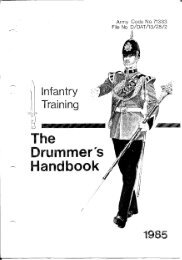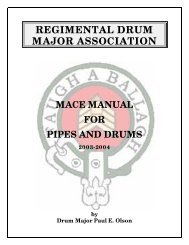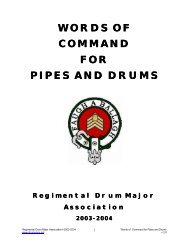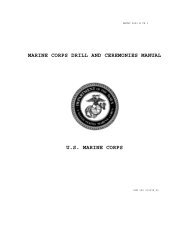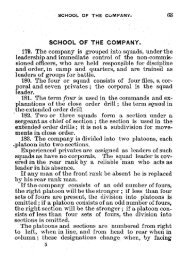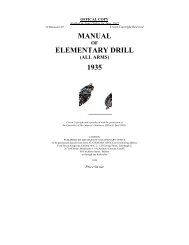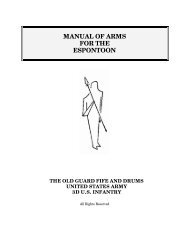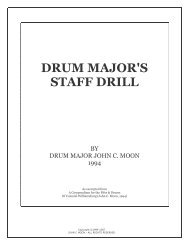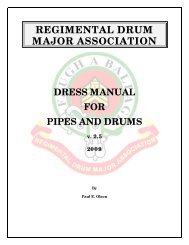The Military Band - Regimental Drum Major Association
The Military Band - Regimental Drum Major Association
The Military Band - Regimental Drum Major Association
Create successful ePaper yourself
Turn your PDF publications into a flip-book with our unique Google optimized e-Paper software.
CHAPTER 1<br />
INTRODUCTION<br />
Section I. PURPOSE AND SCOPE<br />
1. Purpose derstanding and complete evaluation. Comments<br />
a. This manual serves as a guide to command- should be prepared using DA Form 2028 (Recomers<br />
in the training and utilization of an Army mended Changes to Publications) and forwarded<br />
band as a marching, concert, and dance/stage direct to the Commanding Officer, U.S. Army Eleunit<br />
in connection with military ceremonies, for- ment, School of Music, Naval Amphibious Base<br />
mal concerts, and recreational activities. (Little Creek), Norfolk, Virginia 23521.<br />
b. Users of this manual are encouraged to submit<br />
recommended changes and comments to im- 2. Scope<br />
prove the manual. Comments should be keyed to This manual prescribes approved procedures for<br />
the specific page, paragraph, and line of the text the overall functioning of an Army band. Comin<br />
which the change is recommended. Reasons manders will use this manual as a reference for<br />
will be provided for each comment to insure un- the organization and training of an Army band.<br />
Section II. MISSION AND ORGANIZATION<br />
3. Mission 4. Organization<br />
Army musical organizations have served a dis- <strong>The</strong> United States Army has a requirement for<br />
tinctive purpose in the Army since 1775. Army three different types of bands. <strong>The</strong> three types<br />
bands provide commanding officers with an im- are Special, Organizational, and Separate. <strong>The</strong>se<br />
portant and effective means for stimulating and bands are authorized by appropriate tables of ormaintaining<br />
morale and esprit de corps within ganization and equipment approved by the Detheir<br />
units. <strong>The</strong> utility of these units and the es- partment of the Army. <strong>The</strong>se TOE's authorize<br />
teem in which they have been held by field com- the minimum number and distribution of personmanders<br />
may be deduced easily by considering nel for adequate and balanced instrumentation<br />
their permanence for almost 200 years. Through and prescribe necessary equipment to accomplish<br />
participation in military ceremonies, formal con- the mission.<br />
certs, entertainment, recreational activities,<br />
street parades, and other permissible community a. Special. Special bands are assigned as difunctions,<br />
the band contributes directly to the rected by the Department of the Army and norwell-being<br />
of the troops and to community rela- mally are allocated on a basis of one per:<br />
tions. <strong>Band</strong>s, as military units, must maintain the (1) Department of the Army (MDW).<br />
highest standards of military efficiency as well as (2) Department of the Army (CINFO).<br />
musical performance. <strong>Band</strong>s composed of male (3) United States <strong>Military</strong> Academy.<br />
personnel will perform such combat duties as the<br />
exigencies of the situation might demand. This b. Organizational. Organizational bands are altype<br />
of duty should be of such a nature that the located on the following basis: One per Army,<br />
band can remain organically intact, and should be corps, field army support command, area support<br />
limited to activities for which personnel of the group, division, or as otherwise directed by Deband<br />
have been trained and equipped. partment of the Army.<br />
3



